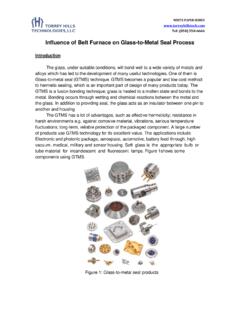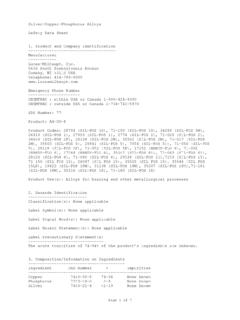Transcription of The Influence of a Belt Furnace on the Brazing …
1 1 WHITE PAPER SERIES Tel: (858) 558-6666 The Influence of a Belt Furnace on the Brazing process introduction " Brazing " refers to a process that is joins metals together. By using a braze alloy or filler metal to unite individual pieces, a strong metallurgical bond is created without melting or changing the essential structure of the original materials. With proper technique, the connection between the metals is often stronger than the actual metals themselves, which ensures the longevity of the bond. While Brazing is one of the oldest processes for joining metals, technological progress has opened the door for Brazing other materials such as ceramic or glass together.
2 Brazing is considered to be essential to many industries, including automotive, aircraft, aerospace, electrical, and more. Additionally, Brazing serves four major purposes for electronics: mechanical, electrical, hermetic and thermal. Although there are different techniques for Brazing , Furnace Brazing specifically allows for high rates of commercial-scale production. Furnace Brazing has many specific advantages. The metals being joined do not have to be the same; dissimilar metals with varying thicknesses can also be united. This allows for complex arrangements of different parts, without distorting the original metals.
3 Multiple joints can also be brazed at the same time. Moreover, superior products can be achieved by Brazing in a Furnace , as furnaces allow for premium reproduction. Furnace atmosphere can be precisely controlled, and this automation is significant. The consistency and quality that Brazing in a belt Furnace produces cannot be paralleled. The Brazing process is straightforward. Typically, filler metals have a melting temperature above 450 C, but their melting point is always less than that of the actual metals being joined. This protects the integrity of the original metals and prevents warping.
4 Once the filler metal reaches its melting point, it flows into the space between the original material to form an alloy at the brazed joint, as Figure 1 depicts. Figure 1: Schematic for Brazing with a belt Furnace , as depicted on 2 WHITE PAPER SERIES Tel: (858) 558-6666 Parameters of Brazing process Because Brazing has certain requirements, Brazing furnaces must be able to support these parameters. Components get heated, joined, and cooled inside of a Furnace , and this entire process is heavily dependent on temperature. The determining factor for the Brazing temperature is based on the melting point of the filler metal.
5 Furthermore, temperature control has a strong Influence on success. Usually, there are five steps to a typical Brazing process cycle: 1) an optional pre-heat, including holding; 2) ramp to temperature; 3) Brazing ; 4) cool down; and 5) exit, as illustrated in Figure 2. During the thermal Brazing cycle, the temperature needs to be precisely controlled by the Furnace . Figure 2: Schematic of a typical Brazing process cycle, as seen in " Furnace Materials #4: Brazing of Metals" by Andersson, Holm, Wiberg, and Astrom. Timing is also very important to the Brazing process . Brazing requires a minimum duration to ensure that the filler metal can flow through the whole joint to make a strong bond.
6 Generally, one or two minutes is enough for this. Too much processing time will yield undesired effects. Typically, the duration of the contact between liquid filler metal and the base metals must be minimized to prevent excess flow of the filler metal. However, in some cases, greater processing time can produce a modified braze alloy that has a higher melting temperature, which could be advantageous in situations where a second Brazing may take place. The atmosphere must be neutral for both the base metal and the braze alloy to avoid oxidation carburizing, decarburization and nitriding. This ensures that no reactions can occur between the metal, alloy, and the atmospheric elements.
7 In addition to oxygen and carbon, it is possible for nitrogen and hydrogen to also trigger reactions in some 3 WHITE PAPER SERIES Tel: (858) 558-6666 circumstances. Likewise, many metals can oxidize rapidly when heated. To avoid this, the Brazing atmosphere inside of a Furnace must be controlled by utilizing a reducing gas such as hydrogen, forming gas, or cracked ammonia. Controlling the Furnace atmosphere is the best way to offset the risk of oxidation and other unwanted issues. Atmosphere Control in a Belt Furnace The amount of oxygen and moisture levels in a Furnace have a direct Influence on the behavior of the filler metal as it melts.
8 For example, when there are low levels of oxygen and moisture in a Furnace , the filler metal has a greater ability to melt and navigate into tight joints and create a stronger bond. High levels of these elements can produce the opposite effect, which is adverse to Brazing . Maintaining strict control of the Furnace atmosphere will significantly improve the quality of the Brazing process and prevent physical defects. Furnace atmospheres contain both neutral and active gases, and these gases can encounter a multitude of reactions. If parts have not been cleaned before entering the Furnace , surface contaminants can interact with the gases and cause unexpected results.
9 Additionally, gases can also react with each other, as well as with vapors from the filler metal. Brazing furnaces allow for precise adjustments within the atmosphere composition in order to produce a balance between the two types of gases. This equilibrium helps to control oxidizing and reducing, as well as carburizing and decarburizing. The atmosphere also has an inevitable effect on the rate of heat transfer within a Furnace 's heating and cooling phases. It is important for atmosphere control systems in Brazing furnaces to include both a system to analyze gas, and also a flow and gas mixture control system in order to control the balance of gases and maintain atmospheric precision.
10 Continuous Brazing furnaces are specifically advantageous for accurate control, in that different Furnace zones can accommodate diverse atmosphere composition set points, as shown in Figure 3. Figure 3: Atmosphere control in belt Furnace , from " Furnace Materials #4: Brazing of Metals" by Andersson, Holm, Wiberg, and Astrom. 4 WHITE PAPER SERIES Tel: (858) 558-6666 Selecting a Furnace for Brazing A high quality Furnace is essential for in order to produce top-quality results from Brazing . The type of products being brazed, characteristics of the materials, production volumes, and schedule can all Influence the Furnace that is best suited for the task.








